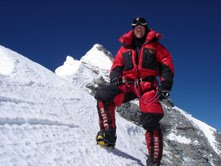
Climbing Everest takes a surprisingly long time. We were camped on the mountain for about two months even before making the final attempt on the summit. This time was spent acclimatizing, setting up camps and thinking about what lay ahead of us. We were actually ready for the final ascent after six weeks but due to high winds we were stuck at 6400m for yet another two weeks. At this height the body breaks itself down and you lose weight rapidly. Mentally you start to think you may never make it. When the wind dropped we finally set off and would take another three days to reach our top camp at 8400m, high on the north face. By this point I was already in a daze and feeling weak. It was cold and very windy, not only was there the lack of oxygen, but I hadn’t slept for two nights and had barely eaten anything for several days due to the nausea brought on by altitude sickness. All I could stomach was a few Pringles. This was not a good starting point even to get out of bed let alone try to climb to the summit. We set off for the final assault at 11pm and climbed through the night. The main challenge is not technical but is being able to deal with the altitude, the cold and the tiredness. Technically it’s not too hard except for the infamous second step at 8550m where Mallory and Irvine disappeared in 1924 and which has been the scene of many fatalities. After this point it seemed to get exponentially harder as one approaches the top. Up until then I had been able to progress slowly, one step at a time but then suddenly with about 200m to go I came to a grinding halt, my body felt totally weak. I felt like I was suffocating and gasping for air.
In preparation I always told myself I would never give up but having just stepped over a dead body I also knew I should also try to make some sensible decisions. High on Everest, no one can help you and if you sit down from exhaustion, you get cold and there’s a good chance you may never get up again. I decided to plough ahead and summitted at about 7am in the morning. I felt relieved more than elated. It was an unnerving place to be standing. I barely had the energy to move and to make matters worse my vision was going blurred. After a few quick photos I started the descent. Initially again I felt very weak but with each step lower the air pressure gradually increased and I started to feel a little better. I started to speed up and then risked descending the second step without really attaching myself firmly to any ropes. This was a big mistake, my crampon got caught in an old rope and I was left dangling over the north face. My hands were gradually slipping off the smooth rocks and my breathing went totally out of control. Somehow I sorted myself out and continued on down , determined to descend the 2500m back to base camp the same day. Halfway down I started to hallucinate. Rocks started to look like people. It was pretty weird but not a total surprise given I hadn’t eaten or slept for a couple of days and was very dehydrated. It started snowing and then I was in a white out and couldn’t see anything and really felt like lying down. I stumbled on and finally got back to an empty base camp (everyone else was still up the mountain) at around 4pm on the same day. I was in pieces. I struggled to eat and drink and could barely sleep as my heart rate was much too high. My lungs felt like they were about to give up. I had an awful nights sleep. It was only when I got back to Kathmandu a few days later then I felt normal and then elated to have made it.
No comments:
Post a Comment